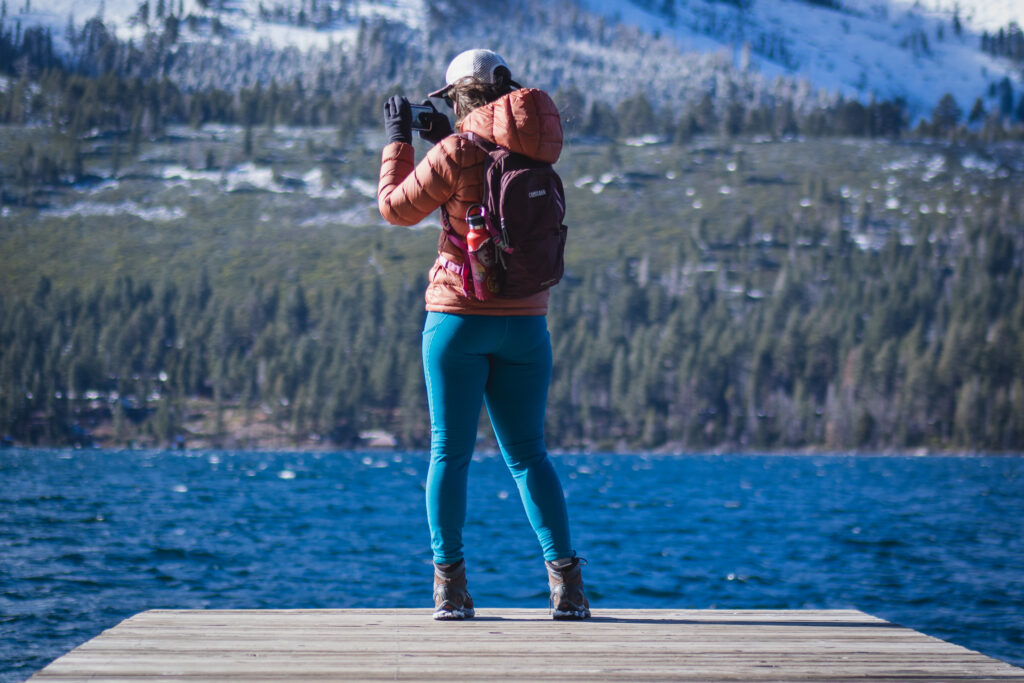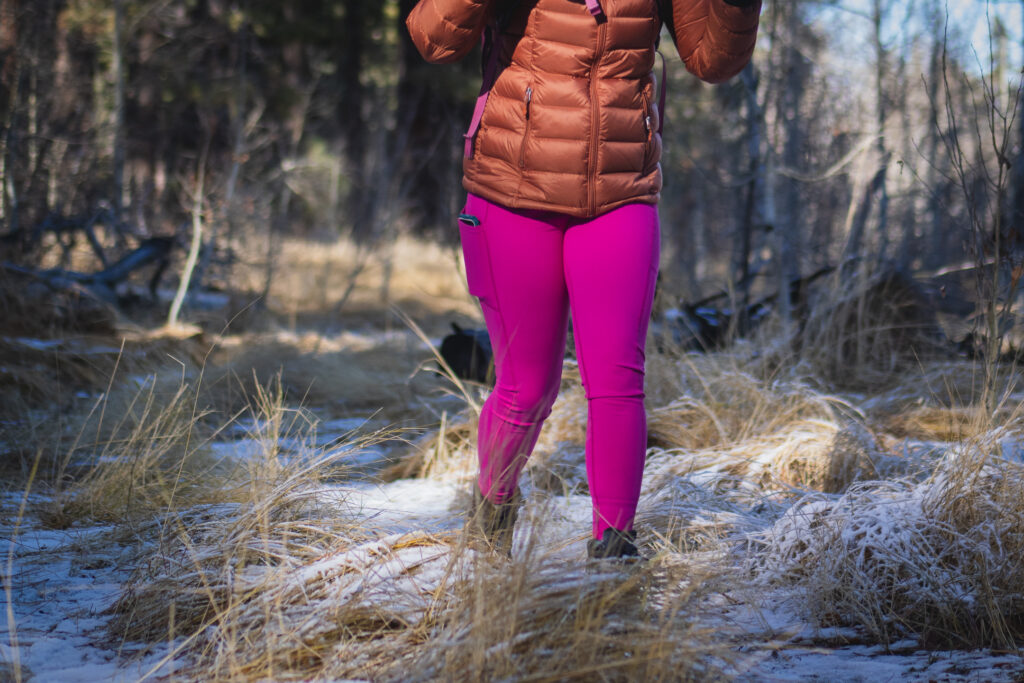
The Fundamentals of Outdoor Clothing
There’s no bad weather, only bad gear, as the saying goes. As hikers, we expect a lot from our clothing. It has to insulate us from the cold, breathe well, dry quickly, and protect us from everything from rain, snow, and wind to intense sun exposure and bugs.
This guide highlights techniques for how to approach your backcountry outfits so you are well-prepared for what the wilderness throws your way.
Layering
Weather and temperatures can fluctuate widely and somewhat wildly, especially at higher elevations. You want to bring clothing that can be layered and either worn all at once for maximum warmth or pared down to base layers if you need to stay cool – it’s all about effective thermoregulation and sweat management. Do bring tops, bottoms, jackets, and accessories that complement each other and work together. Don’t bring multiple items that serve the same purpose and can’t effectively be used in tandem.
On almost every trip, we bring underwear, base layers, a fleece and/or down jacket, rain jacket, and (maybe) rain pants.
Mix & Match
An efficient outdoor clothing system is made up of a collection of essential items that can be mixed and matched. For backpacking, we wear the same basic outfit daily while hiking, and supplement when needed when the weather changes. It’s a delicate balance, but for example, you want a rain jacket that is both loose enough to accommodate a bulkier fleece or puffy jacket underneath but not so baggy that you go swimming in it if you are caught in a warmer rain shower and don’t need the insulating layer.

Embrace the Grime
Even with the most methodical trail hygiene routine (and we do love to stay clean on trail), gear will get gross if you are out for long enough. Having said that, generally, the only garments we have at least two of are socks and underwear, wearing one set during the day and another set at night after we rinse off (and using that clean set as a backup for day use if disaster strikes). It’s also often easy enough to clean (or at least rinse out) clothing periodically.
Materials
Managing moisture is one of the key challenges of staying comfortable and healthy on a trip. Sweat, precipitation, and water crossings are part of the experience so it’s really important that clothing dries quickly. Fabrics that stay wet for a long time (cotton and cotton blends) hold moisture against the skin, which can be a huge problem in cold temperatures and/or high winds since that moisture sucks away body heat much, much faster leading to hypothermia. Even in warm weather, wet clothing also leads to other problems like chafing, blisters, and rashes, all of which can be a real bummer.
Synthetic fabrics, like polyester and nylon, are excellent for wicking moisture away from the skin. They also dry quickly, are fairly durable, lightweight, and affordable. The downside to synthetics is that they tend to hold odors more than natural fibers do.
Natural fibers, like wool, are legendary in the hiking world for their ability to keep you warm even when wet. Fine merino wool is also excellent at helping you thermoregulate in warm weather and is naturally antimicrobial for minimal odor buildup on multi-day trips. Wool clothing has come a long way, but historically, the downsides of wool are that it can feel itchy to some, it’s expensive, and it tends to be less durable than synthetics. Some people also prefer hiking in silk underwear (sounds fancy but it’s super practical) to reduce chafing and rashes on sensitive skin.

Don’t Overpack; Streamline
It’s common for hikers to overpack clothing and layers, making backpacks unnecessarily heavy and bulky. We tend to do this because we’re nervous about being too cold, wet, and dirty out on the trail.
That’s why it really pays to dial in an efficient set of clothes that work together and can be easily adjusted to meet changing conditions. Keeping your clothing system minimal and lightweight will increase your overall comfort by reducing the load strain on your body.
Safety & Comfort
When it comes down to it, clothing choices are about staying comfortable and safe in the myriad elements you’ll encounter in the backcountry. Having the right rain jacket in a storm or sun hat and pants in the sun-scorched desert will keep you happier and healthier on your adventure.
If you know your personal comfort limits and properly prepare, you should feel confident that your shelter, sleep system, clothing, and skills can get you through almost anything nature throws at you.

What to Wear While Hiking & Backpacking (By season)
SUMMER
For summer backpacking trips, when temperatures typically won’t drop below freezing:
On trail:
- hiking shorts
- hiking pants (at high altitude or in desert conditions)
- t-shirt or sun shirt
- quick-dry underwear (or lined shorts)
- lightweight hiking socks
- trail running shoes
- running gaiters
- sun hat
- sunglasses
- windbreaker or rain jacket (to retain heat if it gets chilly)
- liner gloves
- rain pants
- rain mitts
In camp:
- base layer top
- shorts or pants
- warm socks
- warm hat
- down jacket

SPRING & FALL
Shoulder seasons are typically a bit colder and rainier, so they require a few extra clothing items. For these trips, we bring our full summer clothing setup and add a fleece jacket, a full set of base layers, and an extra pair of hiking socks. We may also bring more robust rain gear including rain pants and an umbrella if the forecast looks super wet.
On trail:
- hiking pants or leggings
- t-shirt, sun shirt, or long-sleeve hiking shirt
- quick-dry underwear
- lightweight hiking socks
- trail running shoes or lightweight boots (if snowy/muddy terrain is expected)
- sunglasses
- rain jacket
- rain pants
- rain mitts
- liner gloves
- fleece jacket
In camp:

WINTER
Hiking and backpacking in winter requires a bit more redundancy in clothing since it’s more challenging to stay warm and dry in stormy, sub-freezing conditions. Pay close attention to the weather forecast and make sure your shelter and sleep system are sufficiently warm for nighttime lows.
We typically wear baselayers and a lightweight fleece under rain gear when hiking in wet, cold conditions. In camp, we change into a second set of dry base layers (reserved for camp only) and put on an extra puffy down jacket (cold people may want down pants as well). We also like to have an extra pair of gloves on winter trips since it’s very common for the liner gloves you wear during the day to be wet by nightfall.
On trail:
- baselayer top and bottom
- fleece jacket or midlayer
- rain jacket
- rain pants
- warm hat or hat w/ a brim
- quick-dry underwear
- midweight socks (2 pairs)
- winter boots
- snow gaiters
- sunglasses (really important in the snow)
- rain mitts or shell gloves
- liner gloves
In camp:
- baselayer top and bottom (2nd pair)
- warm socks
- warm hat
- down jacket
- down pants (if you tend to run cold)
- liner gloves (2nd pair)

Things to Keep in Mind While Packing
You won’t need all of this on every trip
Now, before you look at the list below and say, “That’s not ultralight, that’s way too much stuff!” remind yourself that this is all about creating a system that works for you. Choose only the items you truly need with the intention of using them together as a system.

Pick and choose from the items on this list
Create clothing systems for hiking and camping in warm, cool, and wet conditions from the items listed below. Be thoughtful about each piece and build around the most important non-optional items.
Base your decisions off your preferences and the climate/conditions
Prioritize the articles of clothing you’ll wear the most and then think through the trade-offs methodically. Do you want a fleece and a puffy? Maybe. Are you willing to wear your long-sleeved shirt even if it’s warmer than you were expecting? Maybe? Sure it’ll rain, but will it rain pants rain? Maaaybe? Plan for the most extreme weather you know you’ll encounter, but always do what feels right before and during a trip.
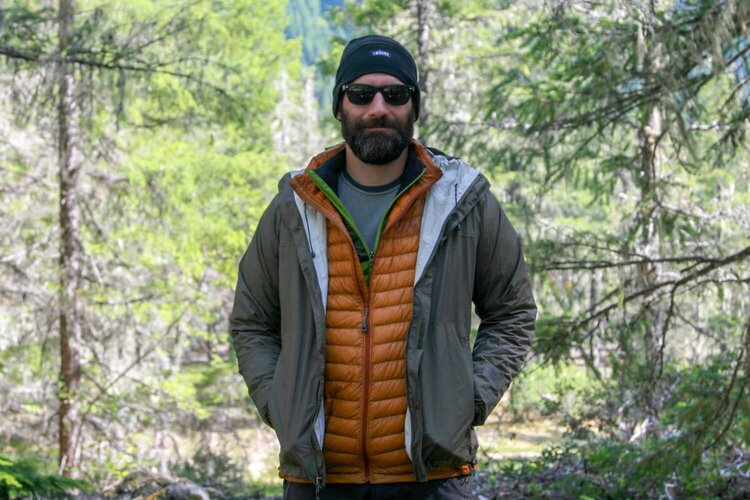
Hiking Clothing Checklist
Ready to start assessing what you’ve already got in your closet and what you may need to buy? Print copies of our free Ultimate Backpacking Checklist and Day Hiking Checklist.
TOP LAYERS
1 Long-Sleeve Shirt
A long-sleeve shirt will be one of the most useful clothing items you bring. Depending on weather conditions and your style preference, you’ll probably want to choose between a UPF sun shirt and a base layer top.
Sun shirts are lightweight, breathable, and can be worn in hot conditions to protect your skin from intense sun and/or mosquitos. A base layer top provides a bit more insulation when hiking in cool conditions. Zip-necks are generally our go-tos since they provide some added ventilation in the neck/chest area.
For more recommendations, see our Best Sun Shirts & Best Base Layers lists
Our Top Picks:

1 Short-sleeve shirt
A lightweight, synthetic or wool t-shirt is a bit more breathable than a long-sleeve, sun shirt and can be comfortable for some when hiking in hot weather. Short sleeves protect your shoulders from abrasions caused by backpack straps better than a tank top for backpacking. The tradeoff is that you’ll have to use more sunscreen and bug repellent if the sun is strong or the mosquitoes are bad.
Our Top Picks:

1 Down or Synthetic Jacket
A warm down or synthetic jacket is your insurance in the backcountry. It’s easy to underestimate how cold it can get in the mountains (and the desert) even during the summer months. Once the sun goes down or the weather shifts, temperatures can swing dramatically.
We wear our down jacket on breaks, around camp, or to supplement our sleep system when it’s exceptionally chilly. Quality down jackets can be expensive, but a good one will undoubtedly become of your most heavily-used pieces of gear.
For more recommendations, see our Best Down Jackets list
Our Top Picks:
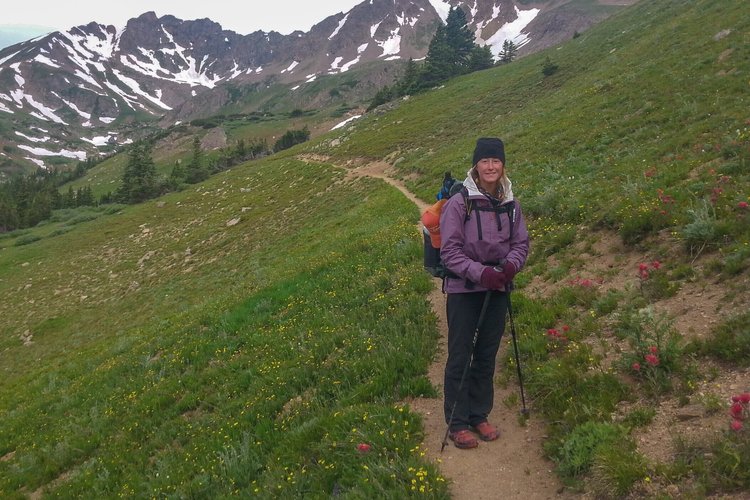
1 Rain Jacket
A lightweight, waterproof rain shell with a hood is an essential item on all hiking and backpacking trips. You will sweat and overheat hiking in rain gear if temps are mild, so rainwear with good ventilation via pit zips and breathable materials are preferred.
Rain jackets are typically worn while hiking or in camp when conditions are wet and cold. A rain jacket can also be worn in windy conditions to help retain heat. Size up to accommodate any layers you plan to wear under your rain jacket (puffy, fleece, baselayer top, etc.).
For more recommendations, see our Best Rain Jackets list
Our Top Picks:
Ponchos & Alternative Rain Gear
Some hikers prefer to use a poncho instead of a rain jacket because they’re lightweight, cover your backpack, have good ventilation, and can also be used as a groundsheet or emergency shelter.
That said, ponchos are also a bit awkward and are much worse at keeping water out in windy conditions. We prefer the versatility of rain jackets and pants, but a lightweight poncho can serve as lightweight emergency rainwear for trips when the weather is expected to be fair. We usually wear a hat with a bill to keep the rain out of our faces with any poncho or rain jacket.
Our Top Picks:

1 Fleece Jacket
Fleece will keep you warm even when it gets wet, which is a key advantage over other insulating layers like down jackets. For that reason, a fleece can be a great addition to your clothing system for cold, wet trips. We prefer light to midweight fleeces with quarter- or full-length zippers.
For more recommendations, see our Best Fleece Jackets list
Our Top Picks:
- Patagonia R1 Air (Men’s / Women’s)
- Columbia Steens Mountain 2.0 & Benton Springs
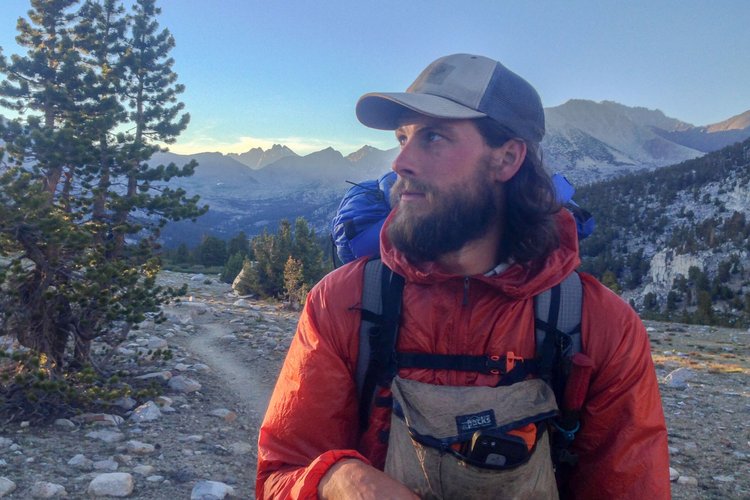
1 Windbreaker
These thin ultralight jackets prevent wind from stripping away body heat. They’re usually made of water-resistant nylon and though they aren’t sufficient protection for sustained rain, they can be worn over a fleece or long-sleeve top to keep you warm in high wind and light mist. Wind shirts are a particularly handy light layer to wear over your long-sleeve shirt when you’re starting to hike in the cool of the morning.
For more recommendations, see our Best Windbreaker Jackets list
Our Top Picks:
1 Base Layer Top
Some backpackers like to like to carry a synthetic, silk, or wool base layer top to wear in camp after a long day on the trail. If this top is in addition to your main hiking shirt, try to keep it as lightweight and compact as possible.
For more recommendations, see our Best Base Layers list
Our Top Picks:

BOTTOM LAYERS
1 Pair Hiking Pants
Worn while hiking in mild or cooler weather, or even in hot weather instead of shorts for added protection from brush, sun, and mosquitoes/ticks. We look for pants that are lightweight, breathable, and quick-drying. It also helps when they’re relatively durable and have a pocket configuration that’s convenient on the trail.
For more recommendations, see our Best Hiking Pants (Women’s / Men’s) and Best Leggings (Women’s) lists
Our Top Picks:

1 Pair Shorts
Hiking shorts are breathable and offer excellent freedom of movement, so they’re generally our top choice when bugs aren’t biting and we’re not bushwhacking. The waistband should be comfortable under a hipbelt. Shorts with a liner also make it possible to hike with one less pair of underwear.
For more recommendations, see our Best Hiking Shorts (Men’s / Women’s) lists
Our Top Picks:

1 Pair Rain Pants
A lightweight, waterproof, but minimalist rain shell. Full-length zippers make it easier to put them on and take them off without removing your shoes/boots, but that also makes them heavier. Worn while hiking or in camp when conditions are wet, cold, or windy.
For more recommendations, see our Best Rain Pants list
Our Top Picks:
- Mountain Hardwear Stretch Ozonic (Men’s / Women’s)
- Outdoor Research Helium (Men’s / Women’s)
- Montbell Versalite (Men’s / Women’s)
1 Pair Base Layer Bottoms
Lightweight or ultralight, synthetic, silk, or wool. Usually reserved for wearing in camp and sleeping in, but can be worn under other layers when necessary for hiking in very wet or cold weather.
For more recommendations, see our Best Base Layers list
Our Top Picks:

1 Pair Insulated Pants
In really cold conditions, a pair of down pants can be a lifesaver. We typically only use these for winter trips in the backcountry, but they’re also useful for car camping trips with chilly nights and mornings.
Our Top Picks:
- Mountain Hardwear Stretchdown Pants (Men’s / Women’s)
- Mountain Hardwear Ghost Whisperer Pants (Men’s / Women’s)
- Montbell Light Down Pants (Men’s / Women’s)
1-2 Pairs Underwear
Comfortable, breathable, quick-drying, anti-odor. Worn daily. Cycle between pairs, rinsing out and air-drying them as needed. Keep at least one pair clean by only wearing them in camp after washing up for the day.
Many women also wear a sports bra on the trail. We recommend a comfortable, breathable, quick-drying one that doesn’t fit too tight.
Our Top Picks:
- ExOfficio Give-N-Go 2.0 Underwear (Men’s / Women’s)
- Patagonia Barely Sports Bra

HEADWEAR
1 Sun Hat
A good hiking hat has a brim long enough to cut the sun out of your line of vision. It should also dry quickly, be breathable, and be reasonably packable so that you can store it when not in use. We wear a hat almost all the time while hiking, especially when the sun is intense or when it’s raining (to keep drops out of our faces).
Wide-brimmed hats with neck capes provide the most protection, but they’re not everyone’s favorite style-wise. Baseball and trucker hats work well with hoods, but they don’t protect your ears and neck, so make sure to sunscreen up, use a sun shirt hood, or tuck in a bandana when necessary.
Our Top Picks:
- Patagonia Duckbill Trucker Hat
- Adidas Superlite 2 (Men’s / Women’s)

1 Warm Hat
A warm hat is the easiest piece of clothing to put on or remove quickly for thermoregulation on the go, on breaks, in camp, or in your sleep sack. Fleece is preferable since it will keep you warm even if it gets wet. It provides a huge amount of bang for the buck when you need to get or stay toasty.
Our Top Pick:
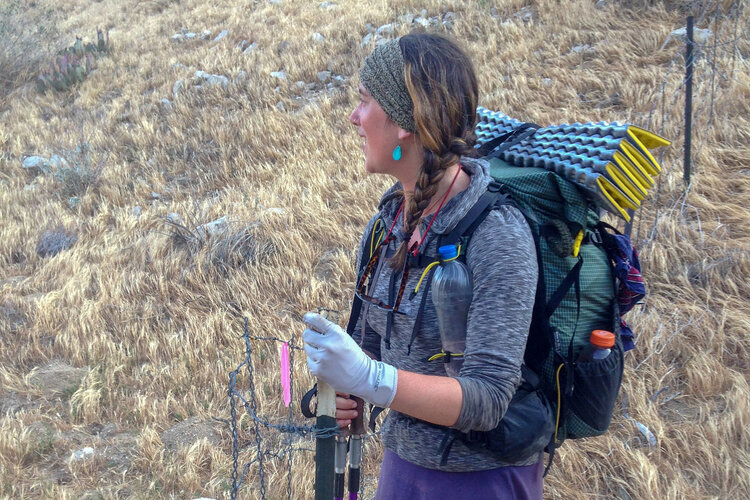
1 Buff
This multifunctional headwear can be worn as a headband, hat, hair band, helmet liner, or balaclava. They’ll also do in a pinch if you need a mini towel, pillowcase, or pot holder. Some people (including a few members of the CleverHiker team) absolutely love these and some opt not to bring them at all.
Our Top Picks:
1 Pair Sunglasses
A good pair of sunglasses (and a protective case) is essential for almost every trip into the backcountry. Polarized sunglasses are preferable since they help cut glare and are easier on the eyes. If viewing pretty scenery is part of your aim, it probably makes sense to get some quality polarized lenses and leave the $10 gas station shades at home. Having said that, there are some fashionable polarized options out there that won’t break the bank.
Our Top Picks:

CAMP CLOTHING
We love having a clean lightweight base layer top and bottom to wear in camp after we’ve washed up at the end of the day. In a pinch, you may have to wear extra layers while hiking when conditions are really cold or wet but either way, you should bring the long johns.
Keeping camp clothes clean requires a little resilience to pull on those soggy socks or sweaty t-shirt before you set out for the day, but in our opinion, it’s well worth it to have clean/dry clothing when you get to camp that night, so we avoid hiking out in our camp clothes.
For recommendations, see our Best Base Layers list.

FOOTWEAR
Choose one of the following shoe options that best suits your trip based on:
- Terrain
- Weather/season/conditions
- Pack weight
- Personal preference/needs

1 Pair Trail Runners or Hiking Shoes
At CleverHiker, we almost always backpack in lightweight trail runners. They minimize blisters, dry quickly, and offer excellent traction. They also keep our feet nimble and don’t exhaust our legs over long days of hiking. Choose a size with a little extra wiggle room in the toe box to allow your feet to swell. Too-tight shoes are a recipe for disaster.
For recommendations, check out our shoe guides:
- Best Hiking Shoes (Men’s / Women’s)
- Best Trail Running Shoes (Men’s / Women’s)
- 5 Reasons to Ditch Your Hiking Boots

1 Pair Lightweight Hiking Boots
Though trail runners have become very popular in most hiking/backpacking circles, many people still prefer the durability and support of hiking boots. Boots offer superior protection on rocky rugged terrain, and on cold, wet trips, especially if extensive snow travel or extremely muddy/mucky trails are involved. Look for lightweight, comfortable boots that will allow your foot to flex, and make sure to break them in well before your hike.
For recommendations, check out our shoe guides:

1 Pair Sandals
Though sandals are still among the least popular options for trail travel, there is a growing population of hikers that prefers them over other footwear choices. When all goes according to plan, sandals are comfortable, breathable, and they dry quickly after river crossings or rain.
That said, sandals provide the least amount of support and they leave your feet open to abrasion from rocks and other sharp objects along the trail, so watch where you step carefully. If you do wear sandals, bring a pair of wool socks to slip on if the weather gets cold/wet. Also, make sure to bring a first aid kit with plenty of tape to prevent any hot spots so your feet don’t get rubbed raw.
For recommendations, check out our shoe guides:
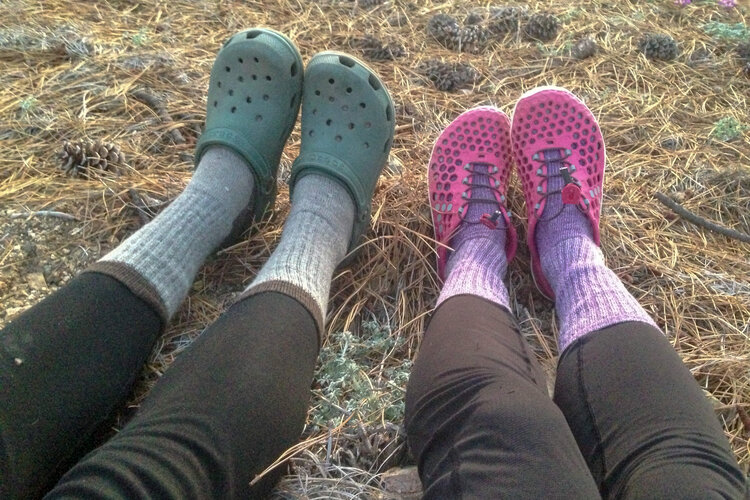
1 Pair Camp Shoes
Though they should be considered a luxury item, some hikers like to carry an alternate pair of shoes to change into for relaxing in camp and wearing in town (if thru-hiking). Good camp shoes are lightweight, compact, dry quickly, and protect the toes. Ideally, they’ll also be compatible with warm socks.
We normally choose to travel without camp shoes, but they can be a nice luxury on wet trips when our hiking shoes/boots are soaked by the time we get to camp.
For more recommendations, check out our Best Camp Shoes list
Our Top Picks:
- Xero Shoes Z-Trail (Men’s / Women’s)
- Vivobarefoot Ultra 3
- Crocs

1 Pair Gaiters
If you wear trail running shoes, a pair of minimalist gaiters will help keep debris from creeping into your shoes. This will keep your feet more comfortable on long trail days and you’ll have far fewer stops to remove pebbles from your shoes. Thru-hikers tend to be big fans of gaiters because they spend so much of their time on the trail. The biggest downsides to gaiters are that they won’t allow your shoes/feet to breathe quite as well and they require one more step every time you put your shoes on or take them off.
Our Top Picks:

SOCKS
1-2 Pairs Hiking Socks
Cycle between pairs of quick-drying wool or synthetic hiking socks, rinsing and drying in direct sunlight when necessary. On cold/wet trips, you may want to bring an extra pair of thick wool socks, which will help keep your feet warm when wet and/or can be used to help dry your shoes after rain showers or river crossings.
1 Pair Camp/Sleep Socks
Keep at least one pair of thick wool socks clean and dry, reserving them for use in camp. On chilly nights you can also sleep with them on to help boost your warmth.
For more recommendations, see our Best Hiking Socks list
Our Top Picks:
- Darn Tough Micro Crew Light Cushion (Men’s / Women’s)
- Farm to Feet Damascus Lightweight Technical ¼ Crew
- Darn Tough Hiker Boot Full-Cushion (Men’s / Women’s) – warm socks

GLOVES & MITTENS
1 Pair Liner Gloves
Basic thin synthetic or wool gloves are the bare minimum you should have to keep your hands warm while on the move. Make sure your liner gloves and rain mitts can be layered together if needed.
1 Pair Fleece gloves
Thin/medium weight gloves are great for hiking and in camp on slightly colder spring and fall trips. Again, make sure these are compatible with your rain mitts.
1 Pair Rain Mitts / Shell Gloves
Waterproof mitts help retain your body heat and can be layered with other gloves to protect your hands from the elements when it’s windy, cold, and wet.
For more recommendations, see our Best Winter Gloves list
Our Top Picks:

ACCESSORIES
Umbrella
In addition to rainwear, an umbrella can be a fantastic addition to your rain system when conditions are particularly wet and the weather changes frequently. Umbrellas are quick and easy to deploy and pack away while on the move and provide convenient rain protection without causing the body to overheat.
In the desert, umbrellas also provide portable shade to protect your skin and eyes from the sun and keep your body temperature lower. For best performance, while hiking, choose an umbrella that’s lightweight, resistant to wind damage, and reflective for maximum cooling potential.
Our Top Picks:
BUG DETERRANTS
Clouds of mosquitoes can easily ruin any backcountry trip, so it pays to do your research and check trip reports. Check online forums or try calling the local ranger station to find out if it’s typical for the bugs to be thick during the dates of your trip. In general, July and August tend to be the worst months for mosquitoes. If the mosquitos are going to be voracious, don’t cancel your trip, just prepare by doing the following:
Wear breathable, but tightly-woven clothing that covers your arms and legs.
- ExOfficio BugsAway Long-Sleeve Shirt (Men’s) & ExOfficio BugsAway Lumen Hoody (Women’s)
- ExOfficio BugsAway Pants (Men’s / Women’s)
Treat your clothing with Permethrin spray pre-trip.
- Clothing Treatment: Permethrin
Use a little Picaridin lotion on exposed skin.
- Topical Bug Repellant: Picaridin Lotion
Wear a head net over a hat. They’re a bit annoying at first, but they keep bugs from getting in your ears, eyes, and mouth. It beats breathing in mosquitos while you’re sucking wind!
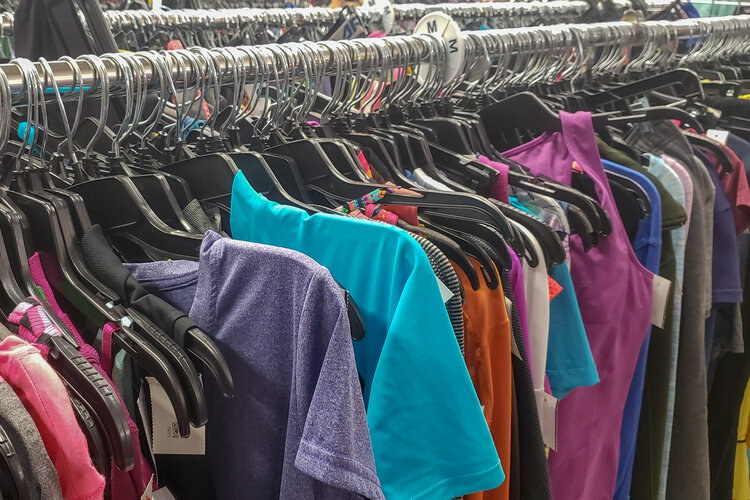
THRIFTING
If you’re short on cash, you can find a lot of perfectly functional used clothing from thrift stores if you know what you’re looking for. Pay attention to fabrics, fit, comfort, and weight. Check the activewear section, which is often full of synthetic t-shirts, long-sleeve tops, shorts, and fleece jackets. We’ve found some absolute steals this way.
Learn the Basics
If you’re a visual learner, you might also enjoy our Ultralight Clothing and Rain Gear Video.
Also, feel free to print a copy of our free Ultimate Backpacking Checklist to start assessing what you’ve already got in your closet and what you may need to pick up.






